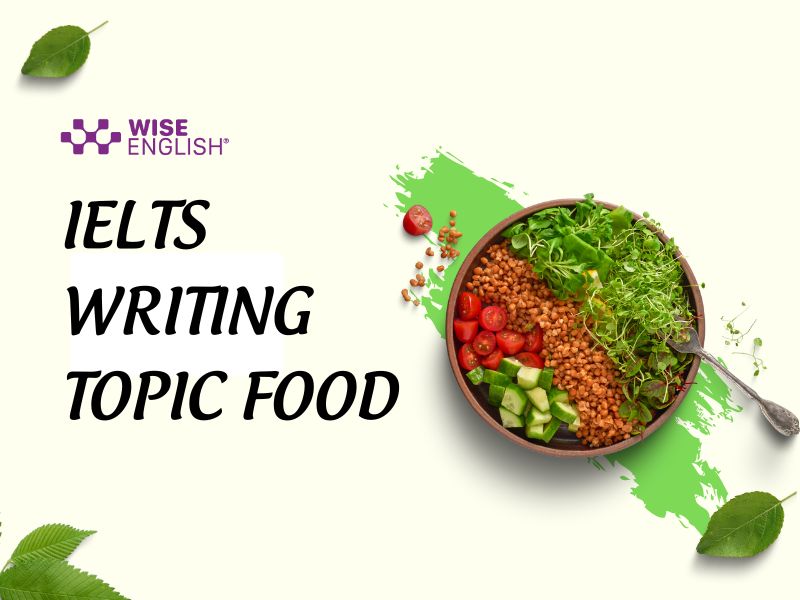IELTS Writing topic Food chắc hẵn đã không còn quá xa lạ với các “chiến binh” đang ôn thi IELTS Writing. Cùng WISE ENGLISH điểm qua các từ vựng và đề bài thường gặp, đì kèm với đó WISE sẽ cung cấp cho bạn các bài mẫu hay mà bạn có thể tham khảo để bổ sung cho bài writing của mình hay hơn. Cùng xem qua nhé!

1. Từ vựng hay thường gặp trong IELTS writing topic Food
Dưới đây, WISE ENGLISH đã tổng hợp một số từ vựng thường gặp và các từ vựng nâng cao mới nhất, để bạn có thể tham khảo thêm và áp dụng vào bài viết của mình tốt hơn.
1.1. Từ vựng thường gặp trong chủ đề Food
| Từ vựng | Loại từ | IPA | Ý nghĩa | Ví dụ |
| Cuisine | Noun | /kwɪˈziːn/ | Ẩm thực | Vietnamese cuisine is famous for its fresh herbs and flavors. |
| Nutrient | Noun | /ˈnjuː.tri.ənt/ | Chất dinh dưỡng | Vegetables are rich in essential nutrients. |
| Organic | Adjective | /ɔːˈɡæn.ɪk/ | Hữu cơ | Many people prefer organic food for its health benefits. |
| Processed | Adjective | /ˈprəʊ.sest/ | Chế biến sẵn | Processed food often contains high levels of salt and sugar. |
| Obesity | Noun | /əʊˈbiː.sə.ti/ | Bệnh béo phì | Childhood obesity is becoming a serious health issue. |
| Balanced diet | Noun phrase | /ˈbæl.ənst ˈdaɪ.ət/ | Chế độ ăn cân bằng | A balanced diet is essential for maintaining good health. |
| Calorie | Noun | /ˈkæl.ər.i/ | Calo | Consuming too many calories can lead to weight gain. |
| Malnutrition | Noun | /ˌmæl.njuːˈtrɪʃ.ən/ | Suy dinh dưỡng | Malnutrition is a common problem in underdeveloped countries. |
| Junk food | Noun phrase | /ˈdʒʌŋk ˌfuːd/ | Đồ ăn nhanh | Junk food is popular for its convenience but is often unhealthy. |
| Staple food | Noun phrase | /ˈsteɪ.pl ˌfuːd/ | Lương thực chính | Rice is a staple food in many Asian countries. |
| Fast food | Noun phrase | /ˈfæst ˌfuːd/ | Đồ ăn nhanh | Fast food is widely consumed for its convenience despite health concerns. |
| Saturated fat | Noun phrase | /ˈsætʃ.ə.reɪ.tɪd ˌfæt/ | Chất béo bão hòa | Too much saturated fat can increase the risk of heart disease. |
| Food security | Noun phrase | /ˈfuːd sɪˌkjʊə.rɪ.ti/ | An ninh lương thực | Governments need to ensure food security for their populations. |
| Agricultural | Adjective | /ˌæɡ.rɪˈkʌl.tʃər.əl/ | Thuộc về nông nghiệp | Agricultural practices need to adapt to climate change. |
| Superfood | Noun | /ˈsuː.pə.fuːd/ | Thực phẩm siêu dinh dưỡng | Blueberries are often referred to as a superfood. |
| Food additives | Noun phrase | /ˈfuːd ˈæd.ɪ.tɪvz/ | Chất phụ gia thực phẩm | Some food additives can cause allergic reactions. |
| Farm-to-table | Adjective | /ˌfɑːrm tə ˈteɪ.bəl/ | Từ nông trại đến bàn ăn | The farm-to-table movement emphasizes locally sourced ingredients. |
| Preservatives | Noun | /prɪˈzɜː.və.tɪvz/ | Chất bảo quản | Many processed foods contain artificial preservatives to extend shelf life. |
| Food wastage | Noun phrase | /ˈfuːd ˈweɪ.stɪdʒ/ | Lãng phí thực phẩm | Reducing food wastage is crucial for a sustainable future. |
| Vegetarian | Noun/Adj | /ˌvedʒ.ɪˈteə.ri.ən/ | Người ăn chay / Thuộc về ăn chay | She became a vegetarian to reduce her carbon footprint. |
1.2. Từ vựng nâng cao về chủ đề Food
Dưới đây là các từ vựng nâng cao liên quan đến chủ đề IELTS Writing topic Food mới nhất giúp bạn nâng cao điểm từ vựng trong bài viết hơn, cùng xem qua nhé!
| Từ vựng | Loại từ | IPA | Ý nghĩa | Ví dụ |
| Culinary arts | Noun phrase | /ˈkʌl.ɪ.nər.i ɑːts/ | Nghệ thuật ẩm thực | Mastering the culinary arts requires years of training and practice. |
| Food insecurity | Noun phrase | /ˈfuːd ˌɪn.sɪˌkjʊə.rɪ.ti/ | Tình trạng thiếu an ninh lương thực | Rising food insecurity is a major challenge in many developing countries. |
| Sustainable diet | Noun phrase | /səˈsteɪ.nə.bəl ˈdaɪ.ət/ | Chế độ ăn bền vững | Adopting a sustainable diet helps protect the environment and conserve resources. |
| Ethical eating | Noun phrase | /ˈeθ.ɪ.kəl ˈiː.tɪŋ/ | Việc ăn uống có đạo đức | Ethical eating involves choosing food that is sustainably sourced and cruelty-free. |
| Carbon footprint | Noun phrase | /ˈkɑː.bən ˈfʊt.prɪnt/ | Dấu chân carbon | Consuming locally grown produce reduces your carbon footprint. |
| Genetically modified organisms (GMOs) | Noun phrase | /dʒəˌnet.ɪ.kəl.i ˈmɒd.ɪ.faɪd ˈɔː.ɡə.nɪ.zəmz/ | Sinh vật biến đổi gen | The debate over the safety of genetically modified organisms continues to divide opinions. |
| Food sovereignty | Noun phrase | /ˈfuːd ˈsɒv.rɪn.ti/ | Quyền tự chủ thực phẩm | Food sovereignty allows communities to have control over their agricultural practices. |
| Locavore | Noun | /ˈləʊ.kə.vɔːr/ | Người ăn thực phẩm địa phương | Being a locavore means prioritizing food grown and produced locally. |
| Pesticide residue | Noun phrase | /ˈpes.tɪ.saɪd ˈrez.ɪ.djuː/ | Dư lượng thuốc trừ sâu | Many consumers are concerned about pesticide residue in fruits and vegetables. |
| Overconsumption | Noun | /ˌəʊ.və.kənˈsʌmp.ʃən/ | Sự tiêu thụ quá mức | Overconsumption of fast food can lead to various health problems. |
| Aquaponics | Noun | /ˌæk.wəˈpɒn.ɪks/ | Hệ thống canh tác thủy canh kết hợp nuôi trồng thủy sản | Aquaponics is a sustainable way to grow food in urban areas. |
| Plant-based diet | Noun phrase | /ˌplɑːntˈbeɪst ˈdaɪ.ət/ | Chế độ ăn dựa trên thực vật | More people are switching to a plant-based diet to improve health and reduce environmental impact. |
| Food transparency | Noun phrase | /ˈfuːd trænsˈpærən.si/ | Sự minh bạch về thực phẩm | Food transparency is essential for building trust between producers and consumers. |
| Caloric density | Noun phrase | /kəˈlɒr.ɪk ˈden.sɪ.ti/ | Mật độ calo | Foods with high caloric density are often less nutritious. |
| Food traceability | Noun phrase | /ˈfuːd ˌtreɪsəˈbɪl.ɪ.ti/ | Truy xuất nguồn gốc thực phẩm | Modern technology enhances food traceability for safer consumption. |
2. Bài mẫu hay cho IELTS writing topic Food
WISE ENGLISH đã tổng hợp các đề bài hay và đã viết các bài mẫu gợi ý, các vị dụ cụ thể để bạn hoàn thành bài viết của mình tốt hơn cho IELTS writing chủ đề Food.
| Đề 1: Some people say that shops should sell food products that are made in the local areas whenever possible rather than are imported from other countries. Do you agree or disagree? |
Introduction
In recent years, the debate over whether shops should prioritize selling locally produced food over imported products has garnered significant attention. While imported food offers consumers variety and year-round availability, I strongly agree that shops should emphasize local food products wherever feasible. This approach not only benefits the local economy but also minimizes the environmental impact of food transportation.
Body Paragraph 1: Economic Benefits of Local Food
Prioritizing locally produced food bolsters the local economy by supporting farmers, small-scale producers, and other related businesses. When consumers buy local, the money stays within the community, creating a positive ripple effect that fosters economic resilience. For instance, a locavore movement in many countries has led to the growth of farmers’ markets, which enable direct interaction between producers and consumers. Furthermore, local food production reduces dependence on imports, safeguarding the economy against global supply chain disruptions.
Advanced Vocabulary Used:
Locavore (/ˈləʊ.kə.vɔːr/): Người ăn thực phẩm địa phương.
Economic resilience (/ˌiː.kəˈnɒm.ɪk rɪˈzɪl.jəns/): Khả năng phục hồi kinh tế.
Body Paragraph 2: Environmental Sustainability
Another compelling argument for selling local food is its positive impact on the environment. Importing food requires long-distance transportation, often by air or sea, which significantly increases the carbon footprint. By contrast, locally sourced products reduce the need for such transportation, contributing to lower greenhouse gas emissions. For example, fruits flown in from other continents can have a higher environmental cost compared to seasonal local produce. Encouraging the consumption of local food aligns with sustainable diet practices, which prioritize environmental protection and resource conservation.
Advanced Vocabulary Used:
Carbon footprint (/ˈkɑː.bən ˈfʊt.prɪnt/): Dấu chân carbon.
Sustainable diet (/səˈsteɪ.nə.bəl ˈdaɪ.ət/): Chế độ ăn bền vững.
Body Paragraph 3: Limitations and Counterarguments
However, some critics argue that limiting shops to local food could restrict consumer choice and lead to higher prices. For instance, tropical fruits or specialty items may be unavailable in certain regions, leading to dissatisfaction among consumers. While this concern is valid, I believe it can be addressed through a balanced approach. Shops could prioritize local food while still offering select imported products to meet diverse tastes. Moreover, government subsidies for local farmers can help make local food more affordable, ensuring accessibility for a wider audience.
Advanced Vocabulary Used:
Consumer choice (/kənˈsjuː.mər tʃɔɪs/): Sự lựa chọn của người tiêu dùng.
Government subsidies (/ˈsʌb.sɪ.diz/): Trợ cấp của chính phủ.
Conclusion
In conclusion, while imported food provides variety, emphasizing local food in shops is a more sustainable and economically advantageous approach. By supporting local farmers and reducing the environmental impact of food transportation, this practice promotes long-term benefits for both the community and the planet. Therefore, I firmly advocate for a shift toward locally sourced food products wherever possible.
Band-Boosting Vocabulary Recap:
Locavore
Economic resilience
Carbon footprint
Sustainable diet
Consumer choice
Government subsidies
This essay effectively balances arguments, incorporates advanced vocabulary, and offers clear opinions supported by evidence. It should comfortably achieve a Band 8.0 or higher for Lexical Resource and Task Response.
Do the advantages overweigh the disadvantages?
| Đề 2: The rise of convenience foods has helped people keep up with the speed of the modren life style. What are the advantages of this trend? Do the advantages overweigh the disadvantages? |
In today’s fast-paced world, convenience foods have become a staple in many households, offering a quick and efficient way to meet dietary needs. While such foods provide undeniable benefits, such as time savings and accessibility, they also come with significant drawbacks, particularly regarding health and environmental sustainability. I believe that while convenience foods cater well to modern lifestyles, their disadvantages outweigh their advantages in the long run.
Body Paragraph 1: Advantages of Convenience Foods
One major advantage of convenience foods is their ability to save time, a critical factor in the lives of busy professionals and families. Pre-packaged meals and ready-to-eat snacks eliminate the need for extensive preparation, allowing individuals to focus on work, family, and leisure activities. Additionally, convenience foods are widely available, making them an accessible option for people living in urban areas with limited time or cooking skills. For instance, frozen meals and instant noodles are affordable and easy to prepare, making them popular choices.
Moreover, the rise of nutritionally balanced convenience options, such as fortified cereals and pre-portioned salads, has somewhat mitigated concerns about the lack of nutrition in such foods. This ensures that even those with limited time can access relatively healthy options.
Advanced Vocabulary Used:
Time savings (/taɪm ˈseɪ.vɪŋz/): Tiết kiệm thời gian.
Pre-packaged (/ˌpriːˈpækɪdʒd/): Đóng gói sẵn.
Nutritionally balanced (/njuːˈtrɪʃənəli ˈbælənst/): Cân đối dinh dưỡng.
Body Paragraph 2: Disadvantages of Convenience Foods
Despite these advantages, the drawbacks of convenience foods are concerning. Chief among them is the negative impact on health. Many convenience foods are high in preservatives, unhealthy fats, and excessive amounts of salt and sugar, contributing to the global rise in obesity, diabetes, and cardiovascular diseases. For example, frequent consumption of processed snacks and sugary drinks has been directly linked to long-term health issues.
Additionally, the widespread reliance on convenience foods can lead to a decline in traditional cooking skills and a lack of awareness about fresh and wholesome ingredients. This shift has implications for cultural traditions and dietary habits, particularly in societies where home-cooked meals have historically been a cornerstone of family life.
Advanced Vocabulary Used:
Preservatives (/prɪˈzɜː.və.tɪvz/): Chất bảo quản.
Cardiovascular diseases (/ˌkɑː.di.oʊˈvæs.kjə.lər dɪˈziːzɪz/): Các bệnh tim mạch.
Wholesome ingredients (/ˈhoʊl.səm ɪnˈɡriː.di.ənts/): Nguyên liệu lành mạnh.
Body Paragraph 3: Environmental Concerns
Another disadvantage of convenience foods is their environmental impact. The production, packaging, and transportation of these products contribute significantly to plastic waste and greenhouse gas emissions. For instance, single-use plastic containers and wrappers from pre-packaged meals often end up in landfills or oceans, exacerbating pollution. Encouraging a reliance on convenience foods may inadvertently undermine global efforts toward environmental sustainability.
Advanced Vocabulary Used:
Greenhouse gas emissions (/ˈɡriːn.haʊs ˌɡæs ˌɪˈmɪʃ.ənz/): Khí thải nhà kính.
Single-use plastic (/ˈsɪŋ.ɡl ˌjuːs ˈplæs.tɪk/): Nhựa dùng một lần.
Environmental sustainability (/ɪnˌvaɪ.rənˈmen.təl səˌsteɪ.nəˈbɪl.ə.ti/): Bền vững môi trường.
Conclusion
While the rise of convenience foods aligns well with the demands of modern lifestyles by offering time savings and accessibility, the disadvantages—including adverse health effects, cultural erosion, and environmental harm—are significant. Therefore, I believe the drawbacks outweigh the benefits. Encouraging a balanced approach that incorporates both convenience and nutritional value, while minimizing environmental damage, is key to addressing this issue.
Band-Boosting Vocabulary Recap:
Time savings
Pre-packaged
Nutritionally balanced
Preservatives
Cardiovascular diseases
Wholesome ingredients
Greenhouse gas emissions
Single-use plastic
Environmental sustainability
You do NOT need to write your own address
| Đề 3: You are going to study in a college in the UK next year. You would like to stay in a college Hall of Residence. Write a letter to the college giving your accommodation requirements. You should outline what your room and food needs are and also ask what alternatives are available if they cannot provide what you want. You should write at least 150 words. You should spend about 20 minutes on this task. You do NOT need to write your own address. |
Dear Sir/Madam,
I am writing to inquire about accommodation options in the Hall of Residence for the upcoming academic year, as I will be joining your college as a full-time student.
Regarding my accommodation preferences, I would greatly appreciate a single room with an en-suite bathroom to ensure privacy and convenience. Additionally, it would be ideal if the room were located in a quiet area of the residence, as I require a peaceful environment to focus on my studies. Access to a shared kitchen would also be beneficial, as I occasionally enjoy cooking my own meals.
In terms of food requirements, I would like to inquire if the Hall of Residence offers vegetarian meal options, as I follow a vegetarian diet. If these are unavailable, I would appreciate suggestions for alternatives, such as nearby dining facilities or self-catering options.
Could you also kindly provide information on what alternatives might be available if my preferences cannot be met? I am flexible and open to discussing other possibilities that align with my needs.
Thank you for your assistance. I look forward to your response.
Yours sincerely,
[Your Name]
Advanced Vocabulary Used
En-suite bathroom (/ˌɒn ˈswiːt ˈbɑːθ.rʊm/): Phòng tắm riêng.
Peaceful environment (/ˈpiːs.fəl ɪnˈvaɪ.rən.mənt/): Môi trường yên tĩnh.
Shared kitchen (/ʃeəd ˈkɪtʃ.ən/): Nhà bếp dùng chung.
Self-catering (/ˌselfˈkeɪ.tər.ɪŋ/): Tự phục vụ ăn uống.
Dietary preferences (/ˈdaɪ.ə.ter.i ˈpre.fər.əns.ɪz/): Các lựa chọn ăn uống.
Discuss the advantages and disadvantages?
| Đề 4: These days, fooddays, food travels long distances before reaching consumers, and it is therefore believed that consuming locally grown food would bring about a number of economic and environmental benefits. Discuss the advantages and disadvantages? |
These days, food travels long distances before reaching consumers, and it is therefore believed that consuming locally grown food would bring about a number of economic and environmental benefits. Discuss the advantages and disadvantages.
In recent years, the global food supply chain has seen rapid expansion, with food products often traveling long distances before reaching consumers. This trend has sparked a debate about whether consuming locally grown food could offer several economic and environmental benefits. While there are clear advantages to this approach, there are also some notable drawbacks that should be considered.
One of the primary advantages of consuming locally grown food is the potential for significant environmental benefits. Transportation of food over long distances typically involves the use of fossil fuels, contributing to air pollution and the carbon footprint. By opting for local produce, the energy consumption and associated emissions can be greatly reduced, helping to combat climate change. Furthermore, locally sourced food is often fresher, which can also mean fewer preservatives and additives, contributing to better health for consumers.
In addition to environmental benefits, buying local food supports the local economy. It helps create jobs in agriculture, encourages small-scale farming, and keeps money within the community. Local farmers can enjoy a direct relationship with their customers, which can lead to better prices for both producers and consumers. This strengthens the community’s economic foundation and fosters sustainability in the food industry.
However, there are some disadvantages to this approach. One of the most significant challenges is the limited availability of certain food items. Local climates and growing seasons often restrict the variety of food that can be produced. For instance, tropical fruits and certain vegetables may not be grown in temperate regions, meaning consumers would have to forgo these products or rely on seasonal availability, which could limit dietary diversity. Additionally, local food production may not be as cost-effective as importing food from regions where production costs are lower due to favorable climates or economies of scale.
Moreover, local food systems may not always be as efficient or well-organized as global supply chains, potentially leading to higher prices and inconsistent availability. Large-scale commercial farming operations often benefit from advanced technology and infrastructure, which local producers may not have access to. This could make it difficult for small-scale producers to compete with large-scale agricultural businesses, ultimately raising the cost of locally grown food.
In conclusion, while there are clear environmental and economic benefits to consuming locally grown food, such as reduced carbon emissions and support for local economies, there are also challenges, including limited variety and higher costs. Ultimately, the decision to support local food production should be balanced with consideration for practical limitations and consumer needs. By combining both local and global food sources, a more sustainable and diverse food system can be achieved.
Advanced Vocabulary Used:
Global supply chain (/ˈɡləʊ.bəl səˈplaɪ tʃeɪn/): Chuỗi cung ứng toàn cầu.
Carbon footprint (/ˈkɑː.bən ˈfʊt.prɪnt/): Dấu vết carbon (lượng khí thải carbon).
Preservatives and additives (/prɪˈzɜː.və.tɪvz ənd ˈæd.ɪ.tɪvz/): Chất bảo quản và phụ gia.
Sustainability (/səˌsteɪ.nəˈbɪl.ɪ.ti/): Sự bền vững.
Economies of scale (/ɪˈkɒnəmiːz əv skeɪl/): Kinh tế theo quy mô.
Commercial farming operations (/kəˈmɜːʃəl ˈfɑːmɪŋ ˌɒpəˈreɪʃənz/): Hoạt động canh tác nông nghiệp thương mại.
To what extent do you agree or disagree?
| Đề 5: Some people believe that countries should produce all the food necessary to feed their populations and import as little food as possible. To what extent do you agree or disagree? |
In today’s globalized world, the question of whether countries should aim for food self-sufficiency or rely on imports has been a topic of debate. While some argue that nations should strive to produce all the food required to sustain their populations, I believe that a balanced approach is more practical, taking into account both the benefits and challenges of food production and importation.
On the one hand, the idea of food self-sufficiency offers several compelling advantages. By producing all necessary food domestically, countries can reduce their dependency on foreign nations, ensuring a stable and secure food supply. This can be particularly important in times of geopolitical instability or global supply chain disruptions, as witnessed during the COVID-19 pandemic. Moreover, local food production can bolster the economy by creating jobs in agriculture and supporting local farmers, thus stimulating economic growth. Additionally, domestically produced food tends to be fresher, which may lead to better health outcomes for the population.
However, there are also significant drawbacks to this approach. It is important to consider that not all countries are naturally equipped to produce all types of food due to climatic, geographical, and environmental factors. For example, tropical fruits such as bananas and pineapples cannot be grown in colder climates, and regions with limited arable land may struggle to meet the demand for food without relying on imports. Additionally, the resources required to achieve complete food self-sufficiency could place a heavy burden on the environment. Large-scale agricultural production often leads to overuse of land and water, as well as the use of pesticides and fertilizers, which can harm biodiversity and contribute to climate change.
Furthermore, the global food trade brings economic benefits through comparative advantage, where countries can specialize in producing the food items they are most efficient at growing. For instance, while a country with a temperate climate may excel in producing grains, another with a warmer climate might be better suited to growing vegetables or fruits. By importing food from different regions, countries can enjoy a more diverse diet, often at lower prices. The global food market also allows nations to access food that they might not be able to produce themselves, ensuring food security in the long term.
In conclusion, while striving for food self-sufficiency may offer security and economic benefits, the complexities of climate, geography, and resource management make it impractical for many countries. A balance between domestic food production and strategic imports is essential, enabling countries to provide their populations with a reliable, diverse, and sustainable food supply.
Advanced Vocabulary Used:
Food self-sufficiency (/fuːd ˌsɛlf səˈfɪʃənsi/): Tự cung cấp thực phẩm.
Geopolitical instability (/ˌdʒiːəʊpəˈlɪtɪkəl ˌɪnstəˈbɪləti/): Bất ổn địa chính trị.
Global supply chain disruptions (/ˈɡləʊbəl səˈplaɪ tʃeɪn dɪsˈrʌpʃənz/): Gián đoạn chuỗi cung ứng toàn cầu.
Arable land (/ˈærəbəl lænd/): Đất canh tác.
Comparative advantage (/kəmˈpærətɪv ədˈvɑːntɪdʒ/): Lợi thế so sánh.
Pesticides and fertilizers (/ˈpɛstɪˌsaɪdz ənd ˈfɜːtɪlaɪzərz/): Thuốc trừ sâu và phân bón.
This essay incorporates high-level vocabulary, such as “comparative advantage” and “food self-sufficiency,” and presents a well-rounded argument, critical for achieving a high band score in IELTS Writing Task 2.
3. Tổng kết
Chủ đề IELTS Writing topic Food là một chủ đề không quá khó, nhưng vẫn đòi hỏi bạn cách triển khai ý tưởng và cách viết hay và thu hút., Đồng thời, bạn cũng phải có một lượng lớn từ vựng về chủ đề này.
Bạn hãy tập trung rèn luyện các từ vựng và cấu trúc câu phù hợp với chủ đề này tốt. Hy vọng qua bài viết này, WISE English đã cung cấp cho bạn thông tin hữu ích để có thể áp dụng vào bài ôn thi của mình. Chúc bạn có một kỳ thi thật tốt và đạt được kết kết quả như mong muốn.
📌 Bạn muốn tham khảo phương pháp luyện thi IELTS độc đáo và hiệu quả tại WISE English? Tham khảo ngay Trung tâm Luyện thi IELTS uy tín và hiệu quả
Để giúp bạn ôn luyện hiệu quả cho kỳ thi, WISE ENGLISH cung cấp nguồn tài liệu luyện thi hữu ích bao gồm các Hội thảo sự kiện IELTS, Khóa học luyện thi được gợi ý dựa trên nhu cầu và trình độ của mỗi cá nhân.
Đừng quên follow ngay Fanpage,Group cộng đồng nâng band thần tốc và kênh Youtube WISE ENGLISH để học thêm nhiều bí kíp giúp bạn NÂNG BAND THẦN TỐC và chinh phục các nấc thang của IELTS bằng Phương Pháp Học Vượt Trội và Lộ Trình Cá Nhân Hóa nhé.
Các chủ đề liên quan mà bạn có thể quan tâm:
- Chi tiết cấu trúc đề thi IELTS 2024 và dạng câu hỏi mà bạn cần biết
- Top 6 website cung cấp đề thi thử IELTS Onlinemiễn phí 2024
- Tổng hợp đề thi IELTScập nhật mới nhất
BẠN CÒN BĂN KHOĂN VỀ NỘI DUNG NÀY?
Bạn có thể liên hệ với WISE ENGLISH về nội dung này để nhận giải đáp của các giáo viên band 8.0+















